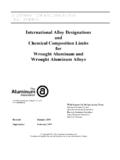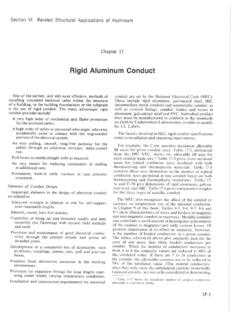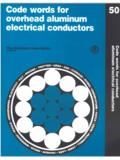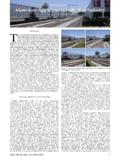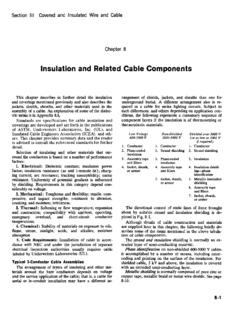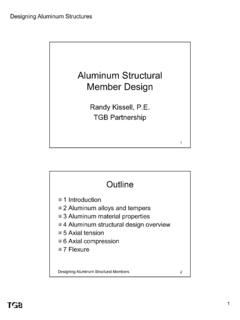Transcription of Bus Conductor Design and Applications
1 Section IV Bus Conductors Chapter 13. Bus Conductor Design and Applications The selection of material for bus conductors is usually Many standard works on bus <;<>nductor are listed at the based on a balance of mechanical and electrical end of this chapter, and numbered references in the text characteristics, economics, and availability. The materials relate to this bibliography. that have been used for bus conductors in large quantity, FIgures 13-1, 2, 9,10, 11,17, 18 and Tables 13-9,10, II, listed in order of volume conductivity, are: silver, copper, 12, 13, 14, 16, 23 have been reprinted with permission aluminum and iron. from the Alcoa aluminum Bus Conductor Handbook Although silver has the highest volume conductivity, it (1957) and other Alcoa Tecltnical Publications; Figures was used as a bus Conductor only during World War II 13-4,28 and Tables 13-3,7 from the Kaiser aluminum Bus when millions of pounds (mostly 14" x 9" bars) were used Conductor Technical ManUal.
2 At various aluminum smelters. The service record was ex . cellent but costs prohibit peacetime use of silver for such AlIOJS and Tempers Applications . Iron in various forms was also used in large volume for Pure aluminum has a conductivity of about 65 percent bus conductors during World War II. In recent years its of the International Annealed Copper Standard (lACS). use is primarily for power rails for rapid transit systems aluminum can be produced percent pure; however, and overhead electrical cranes. However, even for these this purity is costly to achieve and the mechanical proper . Applications its use is declining due to the advantages of ties are low. aluminum and aluminum -steel combinations (Fig. 13-5 m aluminum 1350 is a commercial high-purity aluminum and n). with 61 percent conductivity. The tensile strength of each Copper has excellent mechanical and electrical 1350 temper is determined by the amount of work given characteristics and for many years was the metal of choice the metal during fabrication.
3 Today, most 1350 aluminum for use as bus Conductor . However, the trend has been bus conductors are of -Hlli temper for extrusions, -H112. toward wider use of aluminum for all types of bus installa for sawed rolled plate, and -F for cast bars. tion. After World War II, a new Conductor alloy, 6101, was aluminum has less than one-third the density of copper developed wbich had considerably higher yield strength and, making allowance for conductivity, an aluminum bus and better creep resistance than 1350. The alloy contained bar will weigh about half as much as copper for equal con magnesium and silicon for high mechanical strength ductance. For large installations requiring millions of without significant reduction in conductivity. The strength pounds of metal, bus system designers have used the low of this alloy (6101) is obtained by suitable heat treaunents, cost of aluminum as the basis for optimum economic cur occasionally combined with some cold work.
4 Rent density. The purpose of this chapter is to provide Alloy 6063 has been widely used for outdoor high . technical data on numerous bus Conductor shapes and voltage substation buses because of its excellent alloys as well as answers to basic questions on Design and mechanical and electrical properties and its availability and joining. economy. Where high strength is desirable and conductivi . Typical physical properties given in figures and tables ty requirements are lower, alloy 6061-T6 bus is used. are not guaranteed and may not be exact. They are intend Where high conductivity is reqnired, with a minimum ed for general information only and should not be sacrifice in mechanical properties, alloy 6101 is used in a specified as engineering requirements. Minimum proper variety of shapes. ties for various aluminum product forms, sizes and Other aluminum alloys may be used for bus conductors.
5 Methods of manufacture are available in the aluminum However, they should be used with care since conductivity Assoeiation's aluminum Standards and Data. and mechanical properties can be greatly affected by small 13-1. bus conductors TABLE 13-1 Mechanical Properties of aluminum Bus Conductor and Related Alloys (The aluminum Association; ASTM B 236. B 311. B 241. and B 429; and Manufacturer's Listings) Product Ii l Alloy and temper ! Thickness in Inches Ten,ile Strength Minimum Ultimate (lui). at 20 C (68 F) i Minimum! Typical Yield Ultimate I. i Typical Yield I Typical (a). Elongation (Percent in 2 in. or4 Dial r ; 1350-H III All ; 6101 T6 ; Extruded rod, i 6101-T61 ~ bar tube, pipe i and shapes 6101 T63 I,!, i,'. 6101 HIII i 6101 T64 6101 T65 ! Extruded pipe 6061 T6 ; Pipe size Ie) i & over I min 6063-TS Pipe size,. all min Rolled bar 1350-H12 I Sawed'plate bar ; min or sheet 1350-H 112 I'.
6 Min , min Rolled ,heet ; 1350 ; I 20 30 min i.). (for shearing i 1350-H 12 ! 4-9 min or forming) c!-350-H 14 , i 1350-HI6! 2-4 min tel 1350-H18 ' 24 min Bolts Ib) 2024-T4 1/2-5/8-3/4 NC Cast Alloy 1350-F 1 in. and up for Bus id) 1050. Cast Alloy I. for Fittings if I , TSI ,--"'-----'----- . (a) Elongation values apply to specimens of sizes related to product uses, (b) Values apply to ANSI net stress are. of reguiar or semi-finished bolts. (e) Values apply to ASTM B 429 structural pipe and ASTM B 241 seamless pipe. (d) The designations 1350-F and 1050 are often used in the trade for designating cast bus bars made by run~out into sand molds, or continuous run-out through an orifice. (e) The lower elongation value~pplies to the thinnest sheet. (f) Several casting alloys are suitable for aluminum die-casting of connector fittings. The most frequently used for n mal conditions is (an aluminum Association registered number), suitable both for bolted and welded connections.
7 For special shapes and unusual conditions of installation, where considerable water may be held in the fitting and freeze, some employ a softer alloy having about and ksi minimum ultimate and yield strengths, respectively. and percent or better elongation. There is no registered Association number for this alloy, but in the trade it is often referred to as A l00. 13 2 TABLE 13 2. Physical and Electrical Properties of aluminum Wrought Bus Conductor Alloys (ASTM B 236, B 317, and The aluminum Association). Applying to all alloys and tempers afwroughtalloys, typical Modulus of Elasticity, Typical, psi 10 x 10". Up to 2% higher in values compression Weight, Ib/cu in. (roundedl 0,098. Note: If two values are shown, the more favorable is Specific heat, cal/gmtC or BTU/lb/oF at 70 C for I'typical"; the less favorable is designated "minimum". 1350 and for 6101 1c!)
8 Provided a higher value is favorable. Otherwise the term Coefficient of thermal expansion ( 0,000023. Specific gravity - "guaranteed" is sometimes used. Property Aller Of and temper . --- . ~ 6101'~~416101-T65. 1350 6061-T6 6063-T6. Any temper 6101 T6 6101 T61 6101 T63 Typical Typical Thermal conductivity at 20 C I. ! .5 5, watts/sq. 'C. Volume electrical conductivity at 61-62 55 56 57-58 56 ! 7 I I I 42-43 I 53101. 20 C percent lACS"). 0 . Electrical resistivity (del at 14.! ,5 13,69- 19,39 I S. 20 C (68 FI microhms/sq. (bl 14. 9 18,94. 3. Temperature coefficient of electrical resistance at 20 CrC id ).. 0,00377- 70, .. 377. 0284 o n0277. (sl Typical conductivities of 6101 alloys from Standards of The aluminum Association. The conductivity of 6063 T6 alloy pipe for t~. t ~. outdoor service may be taken as lACS for current ratings, per NEMA Standard.)))
9 <g'. Ib) To obtain de resistance at 20"'C in microhms multiply table value by length in feet and divide by cross sectional area in sq. in. (c) Increasing by for each 100"C above 70'C (specific heat). (dj The higher of a pair of coettlclents corresponds to the higher vafue of the pair of conductivity values. ! - W.. W. lf'. bus conductors TABLE 13-3. Temperature Coefficients of Resistance (dc) for Bus- Conductor aluminum Alloys and Representative Value for Commercial Copper Bus Bar aluminum Alloys and Tempers, and Conductivity % (lACS) fa). 6061 6063 6101 6101 6101 i 6101. 6101 1350 1350 Representative T6 T6 T6 T63 T61 T61 T64 Mini~ Typ; Value Typi Typi Mini~ Mini~ Mini~ Typi Mlni~ mum cal Commercial cal cal mum i mum mum cal I mum j Copper Bus I -t---t--L-J--+-r--~--r--\-~B_ar I. -I~ -!-I-!~!~ ~ ~. 1. % lACS 1 40% 53% (b) 1 55%. Temp,C, 1..:..;..'+.
10 - - - t - - - + . - - - - t - - - \ - - - f - ,r . o .00279 ,00377 ,00392 ,00400 ,00407 ,00415' ,00423 .00427 ,00431 ,00438 ,00446 .00417 10 ,00271 .00363 ,00377 ,00384 ,00391 .00398 .00406 .00409 ,00413 ,00420 I ,00427 .00401 20 ,00264 i ,00350 ,00363 ,00370 ,00377 ,00383 ,00390 .00393 ,00396 ,00403 ,0041 (j .00385 25 ,00261 i ,00344 .00357 ,00363 .00370 .00376 ,00382 ,00386 ,00388 ,003951 .00401 ,00378. 30 ,00257 ,00338 ,00351 ,00357 ,00363 ,00369 .00375 ,00378 .00381 ,00387 .00393 ,00371 40 ,00251 ,00327 ,00339 ,00344 ,00350 ,00356 ,00362 .00364 ,00367 ,00373 ,00379 .00358 50 .00245 ,00317 ,00328 .00333 ,00338 .00344 ,00349 ,00352' .00354 .00360 ,00365 .00345 60 .00239 ,00307 .00317 ,00322 .00327 ,00332 .00337 .00340 .00342 ,00347 ,00352 ,00334. 70 .00233 ,00298 ,00307 .00312 .00316 .00322 .00326 .00329 ,00331, .003351 .00340 ,00323. 80 , ,00298i ,00303 ,00307 ,00312 :,00316 ,003181.)

